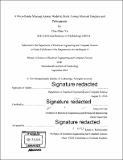| dc.contributor.advisor | Jongyoon Han. | en_US |
| dc.contributor.author | Yu, Chia-Chen (Electrical and computer science engineer) Massachusetts Institute of Technology | en_US |
| dc.contributor.other | Massachusetts Institute of Technology. Department of Electrical Engineering and Computer Science. | en_US |
| dc.date.accessioned | 2017-03-10T15:07:37Z | |
| dc.date.available | 2017-03-10T15:07:37Z | |
| dc.date.copyright | 2016 | en_US |
| dc.date.issued | 2016 | en_US |
| dc.identifier.uri | http://hdl.handle.net/1721.1/107373 | |
| dc.description | Thesis: S.M., Massachusetts Institute of Technology, Department of Electrical Engineering and Computer Science, 2016. | en_US |
| dc.description | Cataloged from PDF version of thesis. | en_US |
| dc.description | Includes bibliographical references (pages 64-67). | en_US |
| dc.description.abstract | Airway mucus hypersecretion or impaired clearance is one of the key pathophysiological features of airborne infection, allergy and severe respiratory diseases. As foreign particles enter the lungs, the airway becomes inflamed and excessive amount of mucus is generated in response. However, little is known about the role of mucus in regulating the passage of potentially harmful particles. In this thesis, we develop a novel in-vitro microfluidic system which closely models the biophysiological properties of the airway system. Our system accommodates co-current flow of aerosol and mucus and reproduces the key physiology of molecular and particle transport into a mucus barrier. A stable air-mucus interface with physiological clearance rate of mucus is achieved by optimizing device structural parameters. Evaporation-driven concentration is observed and limits our system to be used to model particle delivery to the nose and larger airways. With this platform, we hope to perform systematic permeability studies with diseased and normal mucus to develop a detailed understanding of the respiratory mucus permeability towards selected allergens. We envision the device to serve as a broad platform to identify key properties of mucus that may guide the way to improved airway disease diagnosis and treatment. | en_US |
| dc.description.statementofresponsibility | by Chia-Chen Yu. | en_US |
| dc.format.extent | 67 pages | en_US |
| dc.language.iso | eng | en_US |
| dc.publisher | Massachusetts Institute of Technology | en_US |
| dc.rights | MIT theses are protected by copyright. They may be viewed, downloaded, or printed from this source but further reproduction or distribution in any format is prohibited without written permission. | en_US |
| dc.rights.uri | http://dspace.mit.edu/handle/1721.1/7582 | en_US |
| dc.subject | Electrical Engineering and Computer Science. | en_US |
| dc.title | A microfluidic mucosal airway model to study airway mucosal function and pathogenesis | en_US |
| dc.type | Thesis | en_US |
| dc.description.degree | S.M. | en_US |
| dc.contributor.department | Massachusetts Institute of Technology. Department of Electrical Engineering and Computer Science | |
| dc.identifier.oclc | 973557076 | en_US |
